Exploring Tourism's Impacts on Society: A Sociological Study
VerifiedAdded on 2023/06/05
|8
|2607
|100
Essay
AI Summary
This essay investigates the multifaceted relationship between tourism and society, exploring the social, cultural, political, and economic impacts of tourism. It begins by defining tourism and highlighting its role as a significant global industry and a driver of community development. The essay discusses the tourism life cycle model, illustrating how destinations evolve over time, and examines the positive and negative influences of political, economic, and socio-cultural factors on tourism. It further delves into tourist behavior, typologies, and the expectations of travel consumption, emphasizing how these factors impact destinations and societies. The analysis concludes that tourism has both beneficial and detrimental effects, influenced by community preparedness and competence in managing change, and stresses the importance of proactive planning and regulation to ensure a sustainable future for tourism. The essay also acknowledges the recent impact of the pandemic on global tourism and anticipates its inevitable rebound, driven by technological advancements and evolving travel expectations. Desklib offers a variety of study tools and resources, including solved assignments, to support students in understanding complex topics like the sociology of tourism.
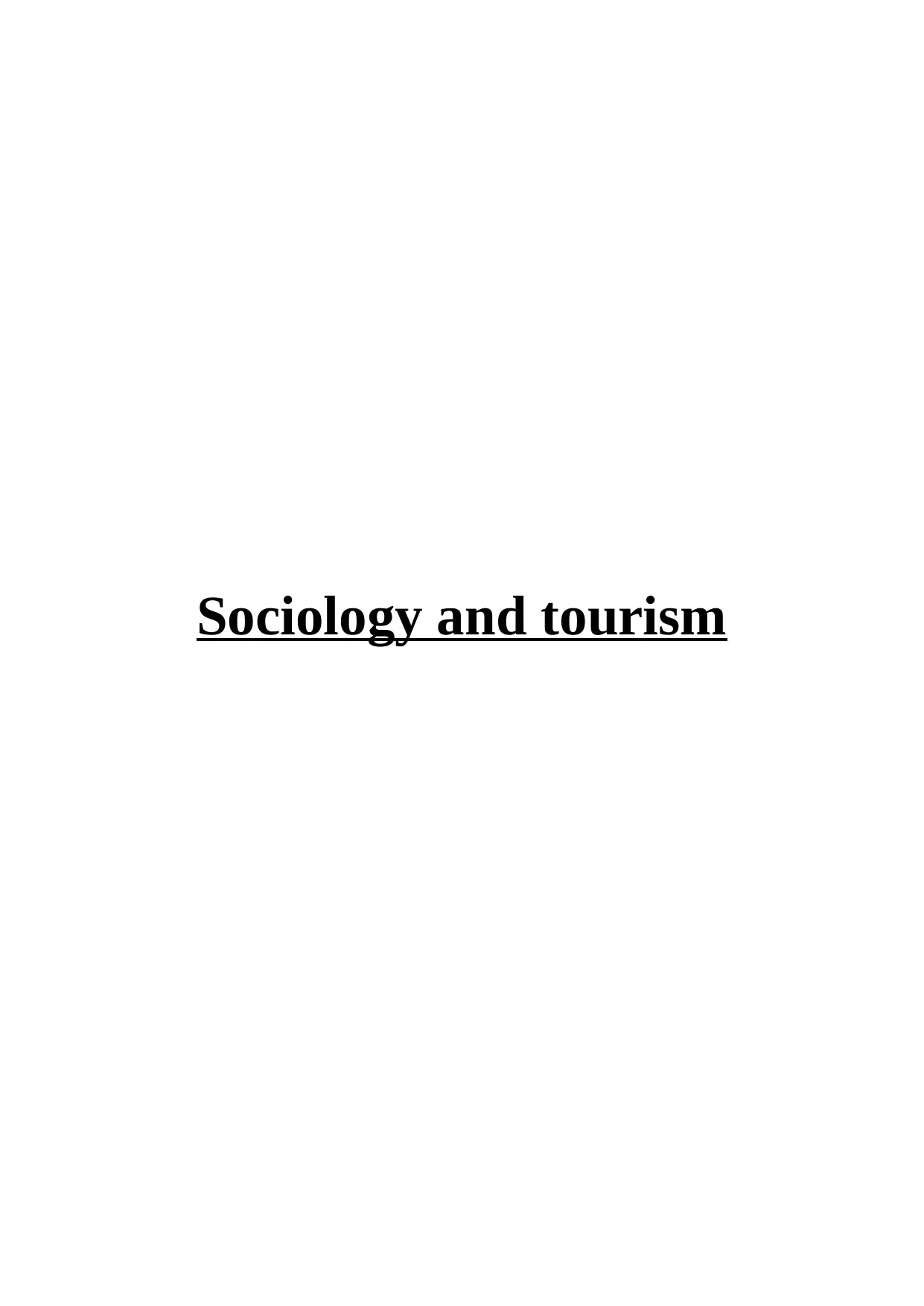
Sociology and tourism
Paraphrase This Document
Need a fresh take? Get an instant paraphrase of this document with our AI Paraphraser
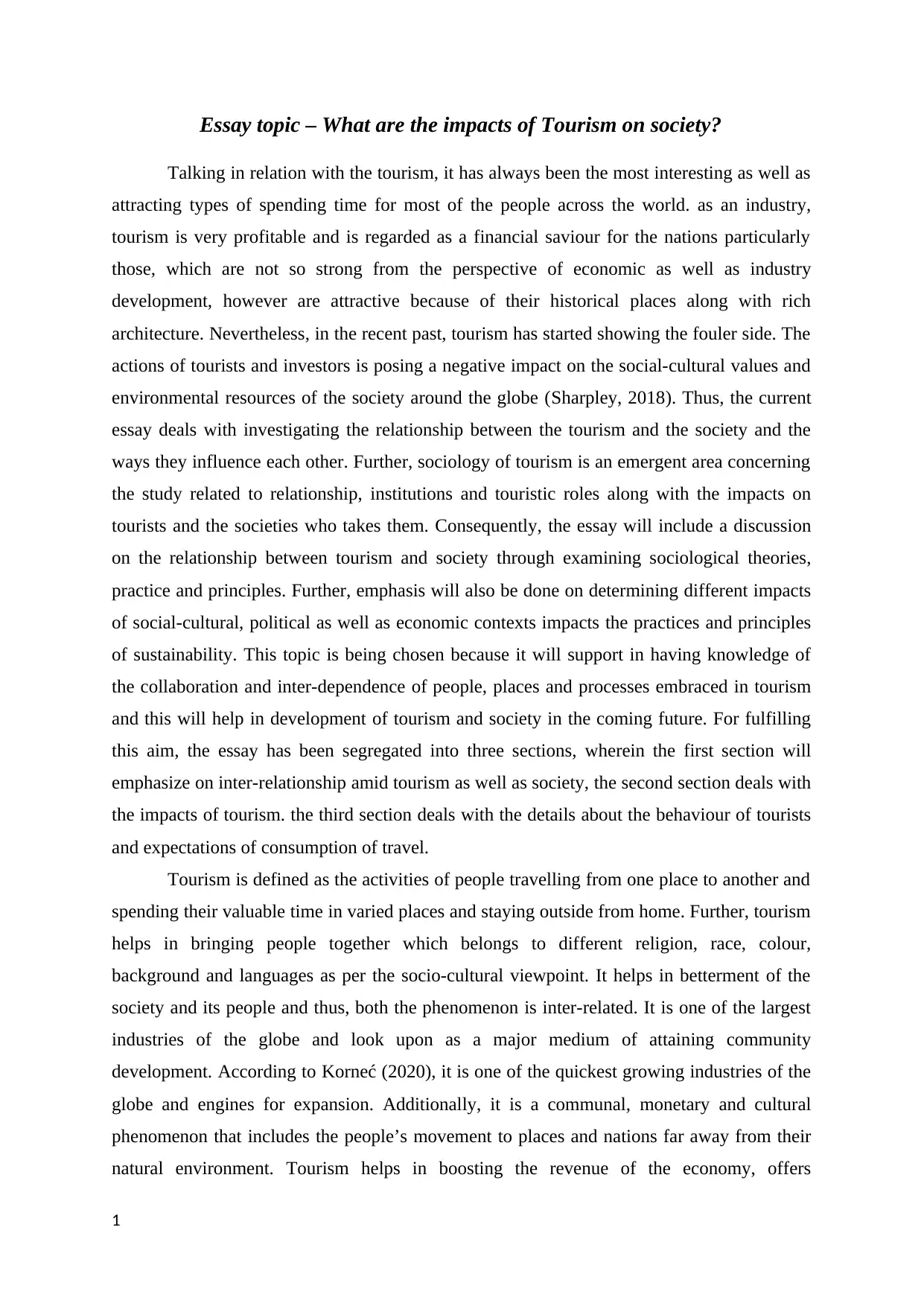
Essay topic – What are the impacts of Tourism on society?
Talking in relation with the tourism, it has always been the most interesting as well as
attracting types of spending time for most of the people across the world. as an industry,
tourism is very profitable and is regarded as a financial saviour for the nations particularly
those, which are not so strong from the perspective of economic as well as industry
development, however are attractive because of their historical places along with rich
architecture. Nevertheless, in the recent past, tourism has started showing the fouler side. The
actions of tourists and investors is posing a negative impact on the social-cultural values and
environmental resources of the society around the globe (Sharpley, 2018). Thus, the current
essay deals with investigating the relationship between the tourism and the society and the
ways they influence each other. Further, sociology of tourism is an emergent area concerning
the study related to relationship, institutions and touristic roles along with the impacts on
tourists and the societies who takes them. Consequently, the essay will include a discussion
on the relationship between tourism and society through examining sociological theories,
practice and principles. Further, emphasis will also be done on determining different impacts
of social-cultural, political as well as economic contexts impacts the practices and principles
of sustainability. This topic is being chosen because it will support in having knowledge of
the collaboration and inter-dependence of people, places and processes embraced in tourism
and this will help in development of tourism and society in the coming future. For fulfilling
this aim, the essay has been segregated into three sections, wherein the first section will
emphasize on inter-relationship amid tourism as well as society, the second section deals with
the impacts of tourism. the third section deals with the details about the behaviour of tourists
and expectations of consumption of travel.
Tourism is defined as the activities of people travelling from one place to another and
spending their valuable time in varied places and staying outside from home. Further, tourism
helps in bringing people together which belongs to different religion, race, colour,
background and languages as per the socio-cultural viewpoint. It helps in betterment of the
society and its people and thus, both the phenomenon is inter-related. It is one of the largest
industries of the globe and look upon as a major medium of attaining community
development. According to Korneć (2020), it is one of the quickest growing industries of the
globe and engines for expansion. Additionally, it is a communal, monetary and cultural
phenomenon that includes the people’s movement to places and nations far away from their
natural environment. Tourism helps in boosting the revenue of the economy, offers
1
Talking in relation with the tourism, it has always been the most interesting as well as
attracting types of spending time for most of the people across the world. as an industry,
tourism is very profitable and is regarded as a financial saviour for the nations particularly
those, which are not so strong from the perspective of economic as well as industry
development, however are attractive because of their historical places along with rich
architecture. Nevertheless, in the recent past, tourism has started showing the fouler side. The
actions of tourists and investors is posing a negative impact on the social-cultural values and
environmental resources of the society around the globe (Sharpley, 2018). Thus, the current
essay deals with investigating the relationship between the tourism and the society and the
ways they influence each other. Further, sociology of tourism is an emergent area concerning
the study related to relationship, institutions and touristic roles along with the impacts on
tourists and the societies who takes them. Consequently, the essay will include a discussion
on the relationship between tourism and society through examining sociological theories,
practice and principles. Further, emphasis will also be done on determining different impacts
of social-cultural, political as well as economic contexts impacts the practices and principles
of sustainability. This topic is being chosen because it will support in having knowledge of
the collaboration and inter-dependence of people, places and processes embraced in tourism
and this will help in development of tourism and society in the coming future. For fulfilling
this aim, the essay has been segregated into three sections, wherein the first section will
emphasize on inter-relationship amid tourism as well as society, the second section deals with
the impacts of tourism. the third section deals with the details about the behaviour of tourists
and expectations of consumption of travel.
Tourism is defined as the activities of people travelling from one place to another and
spending their valuable time in varied places and staying outside from home. Further, tourism
helps in bringing people together which belongs to different religion, race, colour,
background and languages as per the socio-cultural viewpoint. It helps in betterment of the
society and its people and thus, both the phenomenon is inter-related. It is one of the largest
industries of the globe and look upon as a major medium of attaining community
development. According to Korneć (2020), it is one of the quickest growing industries of the
globe and engines for expansion. Additionally, it is a communal, monetary and cultural
phenomenon that includes the people’s movement to places and nations far away from their
natural environment. Tourism helps in boosting the revenue of the economy, offers
1
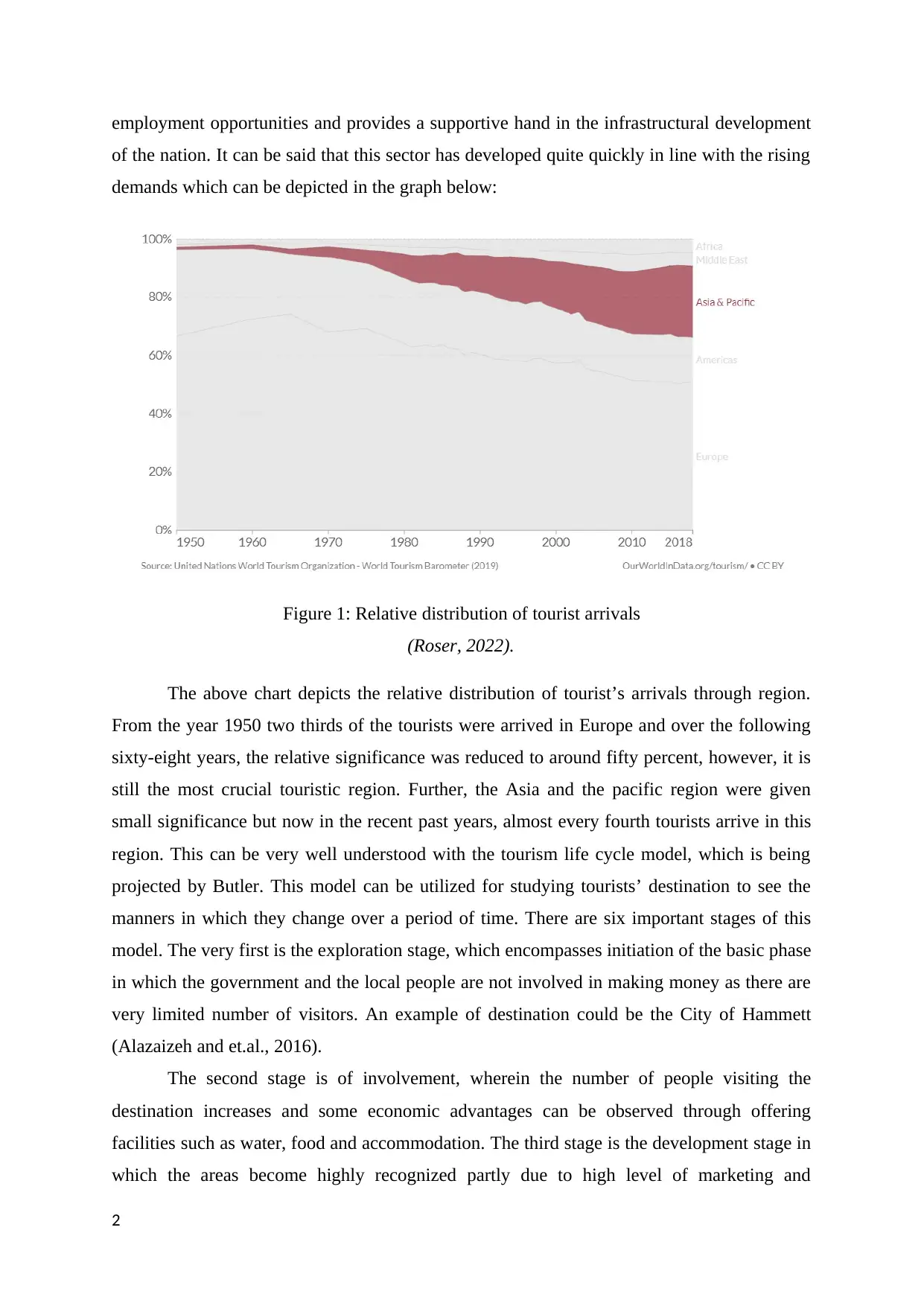
employment opportunities and provides a supportive hand in the infrastructural development
of the nation. It can be said that this sector has developed quite quickly in line with the rising
demands which can be depicted in the graph below:
Figure 1: Relative distribution of tourist arrivals
(Roser, 2022).
The above chart depicts the relative distribution of tourist’s arrivals through region.
From the year 1950 two thirds of the tourists were arrived in Europe and over the following
sixty-eight years, the relative significance was reduced to around fifty percent, however, it is
still the most crucial touristic region. Further, the Asia and the pacific region were given
small significance but now in the recent past years, almost every fourth tourists arrive in this
region. This can be very well understood with the tourism life cycle model, which is being
projected by Butler. This model can be utilized for studying tourists’ destination to see the
manners in which they change over a period of time. There are six important stages of this
model. The very first is the exploration stage, which encompasses initiation of the basic phase
in which the government and the local people are not involved in making money as there are
very limited number of visitors. An example of destination could be the City of Hammett
(Alazaizeh and et.al., 2016).
The second stage is of involvement, wherein the number of people visiting the
destination increases and some economic advantages can be observed through offering
facilities such as water, food and accommodation. The third stage is the development stage in
which the areas become highly recognized partly due to high level of marketing and
2
of the nation. It can be said that this sector has developed quite quickly in line with the rising
demands which can be depicted in the graph below:
Figure 1: Relative distribution of tourist arrivals
(Roser, 2022).
The above chart depicts the relative distribution of tourist’s arrivals through region.
From the year 1950 two thirds of the tourists were arrived in Europe and over the following
sixty-eight years, the relative significance was reduced to around fifty percent, however, it is
still the most crucial touristic region. Further, the Asia and the pacific region were given
small significance but now in the recent past years, almost every fourth tourists arrive in this
region. This can be very well understood with the tourism life cycle model, which is being
projected by Butler. This model can be utilized for studying tourists’ destination to see the
manners in which they change over a period of time. There are six important stages of this
model. The very first is the exploration stage, which encompasses initiation of the basic phase
in which the government and the local people are not involved in making money as there are
very limited number of visitors. An example of destination could be the City of Hammett
(Alazaizeh and et.al., 2016).
The second stage is of involvement, wherein the number of people visiting the
destination increases and some economic advantages can be observed through offering
facilities such as water, food and accommodation. The third stage is the development stage in
which the areas become highly recognized partly due to high level of marketing and
2
⊘ This is a preview!⊘
Do you want full access?
Subscribe today to unlock all pages.

Trusted by 1+ million students worldwide
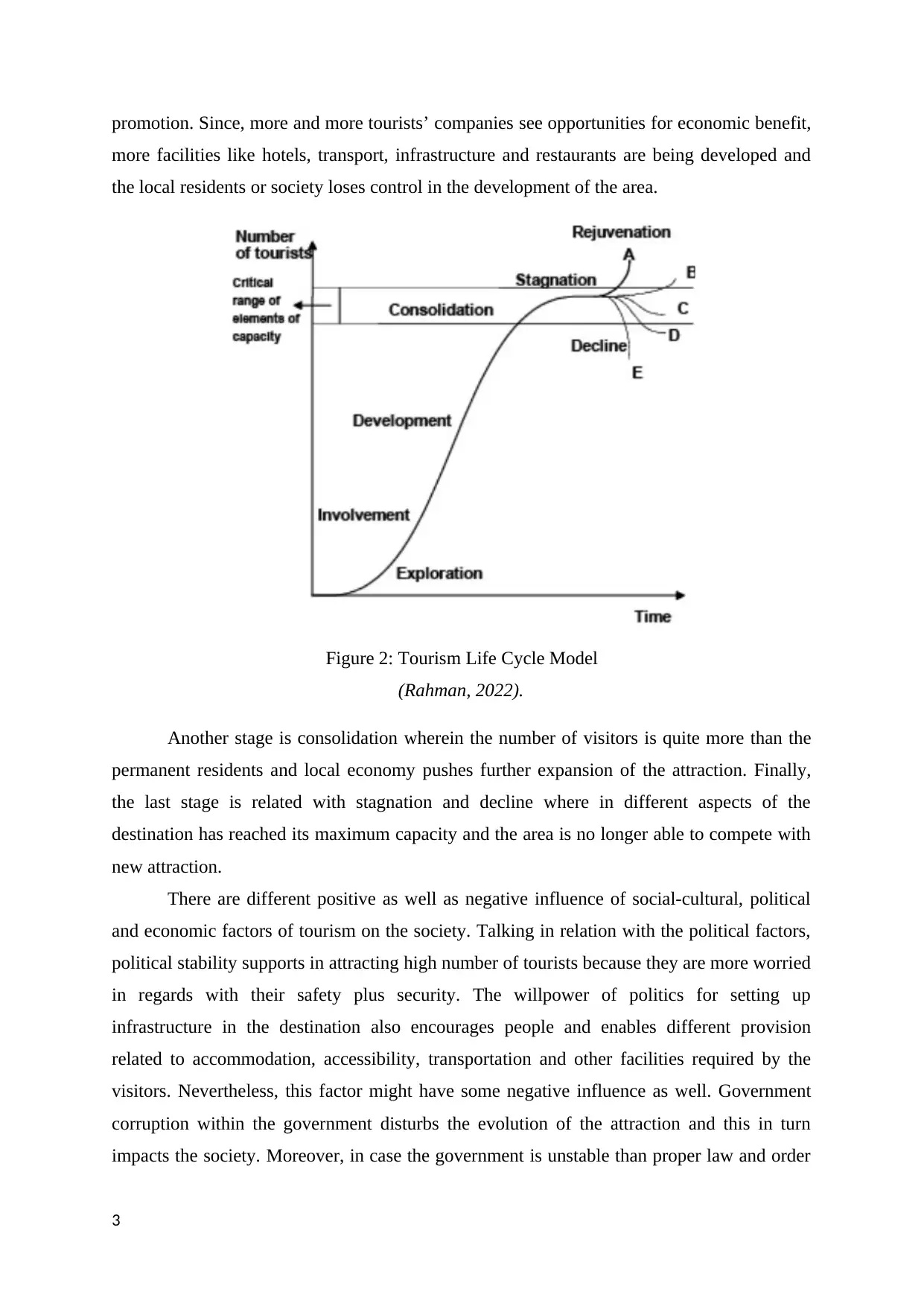
promotion. Since, more and more tourists’ companies see opportunities for economic benefit,
more facilities like hotels, transport, infrastructure and restaurants are being developed and
the local residents or society loses control in the development of the area.
Figure 2: Tourism Life Cycle Model
(Rahman, 2022).
Another stage is consolidation wherein the number of visitors is quite more than the
permanent residents and local economy pushes further expansion of the attraction. Finally,
the last stage is related with stagnation and decline where in different aspects of the
destination has reached its maximum capacity and the area is no longer able to compete with
new attraction.
There are different positive as well as negative influence of social-cultural, political
and economic factors of tourism on the society. Talking in relation with the political factors,
political stability supports in attracting high number of tourists because they are more worried
in regards with their safety plus security. The willpower of politics for setting up
infrastructure in the destination also encourages people and enables different provision
related to accommodation, accessibility, transportation and other facilities required by the
visitors. Nevertheless, this factor might have some negative influence as well. Government
corruption within the government disturbs the evolution of the attraction and this in turn
impacts the society. Moreover, in case the government is unstable than proper law and order
3
more facilities like hotels, transport, infrastructure and restaurants are being developed and
the local residents or society loses control in the development of the area.
Figure 2: Tourism Life Cycle Model
(Rahman, 2022).
Another stage is consolidation wherein the number of visitors is quite more than the
permanent residents and local economy pushes further expansion of the attraction. Finally,
the last stage is related with stagnation and decline where in different aspects of the
destination has reached its maximum capacity and the area is no longer able to compete with
new attraction.
There are different positive as well as negative influence of social-cultural, political
and economic factors of tourism on the society. Talking in relation with the political factors,
political stability supports in attracting high number of tourists because they are more worried
in regards with their safety plus security. The willpower of politics for setting up
infrastructure in the destination also encourages people and enables different provision
related to accommodation, accessibility, transportation and other facilities required by the
visitors. Nevertheless, this factor might have some negative influence as well. Government
corruption within the government disturbs the evolution of the attraction and this in turn
impacts the society. Moreover, in case the government is unstable than proper law and order
3
Paraphrase This Document
Need a fresh take? Get an instant paraphrase of this document with our AI Paraphraser
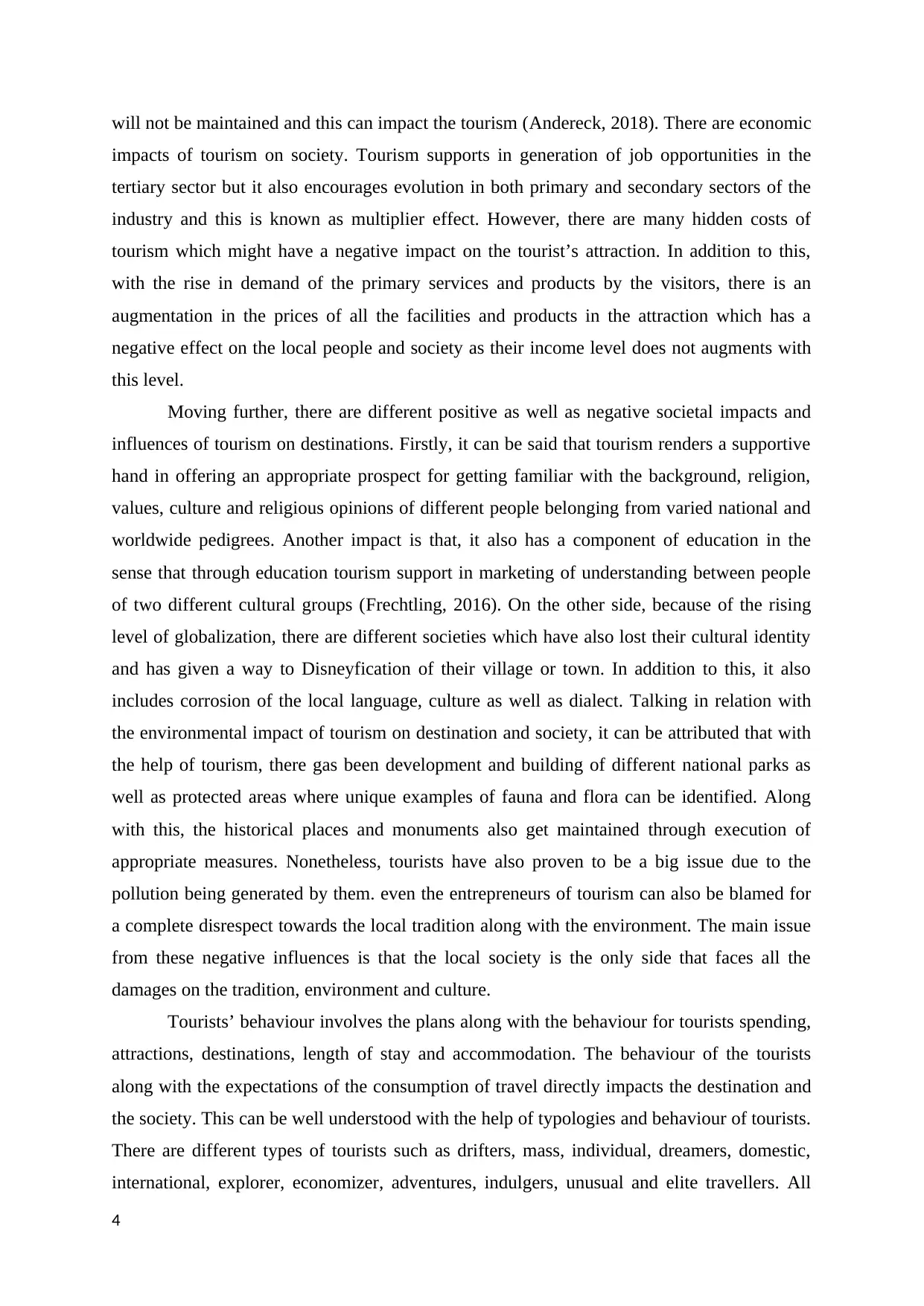
will not be maintained and this can impact the tourism (Andereck, 2018). There are economic
impacts of tourism on society. Tourism supports in generation of job opportunities in the
tertiary sector but it also encourages evolution in both primary and secondary sectors of the
industry and this is known as multiplier effect. However, there are many hidden costs of
tourism which might have a negative impact on the tourist’s attraction. In addition to this,
with the rise in demand of the primary services and products by the visitors, there is an
augmentation in the prices of all the facilities and products in the attraction which has a
negative effect on the local people and society as their income level does not augments with
this level.
Moving further, there are different positive as well as negative societal impacts and
influences of tourism on destinations. Firstly, it can be said that tourism renders a supportive
hand in offering an appropriate prospect for getting familiar with the background, religion,
values, culture and religious opinions of different people belonging from varied national and
worldwide pedigrees. Another impact is that, it also has a component of education in the
sense that through education tourism support in marketing of understanding between people
of two different cultural groups (Frechtling, 2016). On the other side, because of the rising
level of globalization, there are different societies which have also lost their cultural identity
and has given a way to Disneyfication of their village or town. In addition to this, it also
includes corrosion of the local language, culture as well as dialect. Talking in relation with
the environmental impact of tourism on destination and society, it can be attributed that with
the help of tourism, there gas been development and building of different national parks as
well as protected areas where unique examples of fauna and flora can be identified. Along
with this, the historical places and monuments also get maintained through execution of
appropriate measures. Nonetheless, tourists have also proven to be a big issue due to the
pollution being generated by them. even the entrepreneurs of tourism can also be blamed for
a complete disrespect towards the local tradition along with the environment. The main issue
from these negative influences is that the local society is the only side that faces all the
damages on the tradition, environment and culture.
Tourists’ behaviour involves the plans along with the behaviour for tourists spending,
attractions, destinations, length of stay and accommodation. The behaviour of the tourists
along with the expectations of the consumption of travel directly impacts the destination and
the society. This can be well understood with the help of typologies and behaviour of tourists.
There are different types of tourists such as drifters, mass, individual, dreamers, domestic,
international, explorer, economizer, adventures, indulgers, unusual and elite travellers. All
4
impacts of tourism on society. Tourism supports in generation of job opportunities in the
tertiary sector but it also encourages evolution in both primary and secondary sectors of the
industry and this is known as multiplier effect. However, there are many hidden costs of
tourism which might have a negative impact on the tourist’s attraction. In addition to this,
with the rise in demand of the primary services and products by the visitors, there is an
augmentation in the prices of all the facilities and products in the attraction which has a
negative effect on the local people and society as their income level does not augments with
this level.
Moving further, there are different positive as well as negative societal impacts and
influences of tourism on destinations. Firstly, it can be said that tourism renders a supportive
hand in offering an appropriate prospect for getting familiar with the background, religion,
values, culture and religious opinions of different people belonging from varied national and
worldwide pedigrees. Another impact is that, it also has a component of education in the
sense that through education tourism support in marketing of understanding between people
of two different cultural groups (Frechtling, 2016). On the other side, because of the rising
level of globalization, there are different societies which have also lost their cultural identity
and has given a way to Disneyfication of their village or town. In addition to this, it also
includes corrosion of the local language, culture as well as dialect. Talking in relation with
the environmental impact of tourism on destination and society, it can be attributed that with
the help of tourism, there gas been development and building of different national parks as
well as protected areas where unique examples of fauna and flora can be identified. Along
with this, the historical places and monuments also get maintained through execution of
appropriate measures. Nonetheless, tourists have also proven to be a big issue due to the
pollution being generated by them. even the entrepreneurs of tourism can also be blamed for
a complete disrespect towards the local tradition along with the environment. The main issue
from these negative influences is that the local society is the only side that faces all the
damages on the tradition, environment and culture.
Tourists’ behaviour involves the plans along with the behaviour for tourists spending,
attractions, destinations, length of stay and accommodation. The behaviour of the tourists
along with the expectations of the consumption of travel directly impacts the destination and
the society. This can be well understood with the help of typologies and behaviour of tourists.
There are different types of tourists such as drifters, mass, individual, dreamers, domestic,
international, explorer, economizer, adventures, indulgers, unusual and elite travellers. All
4
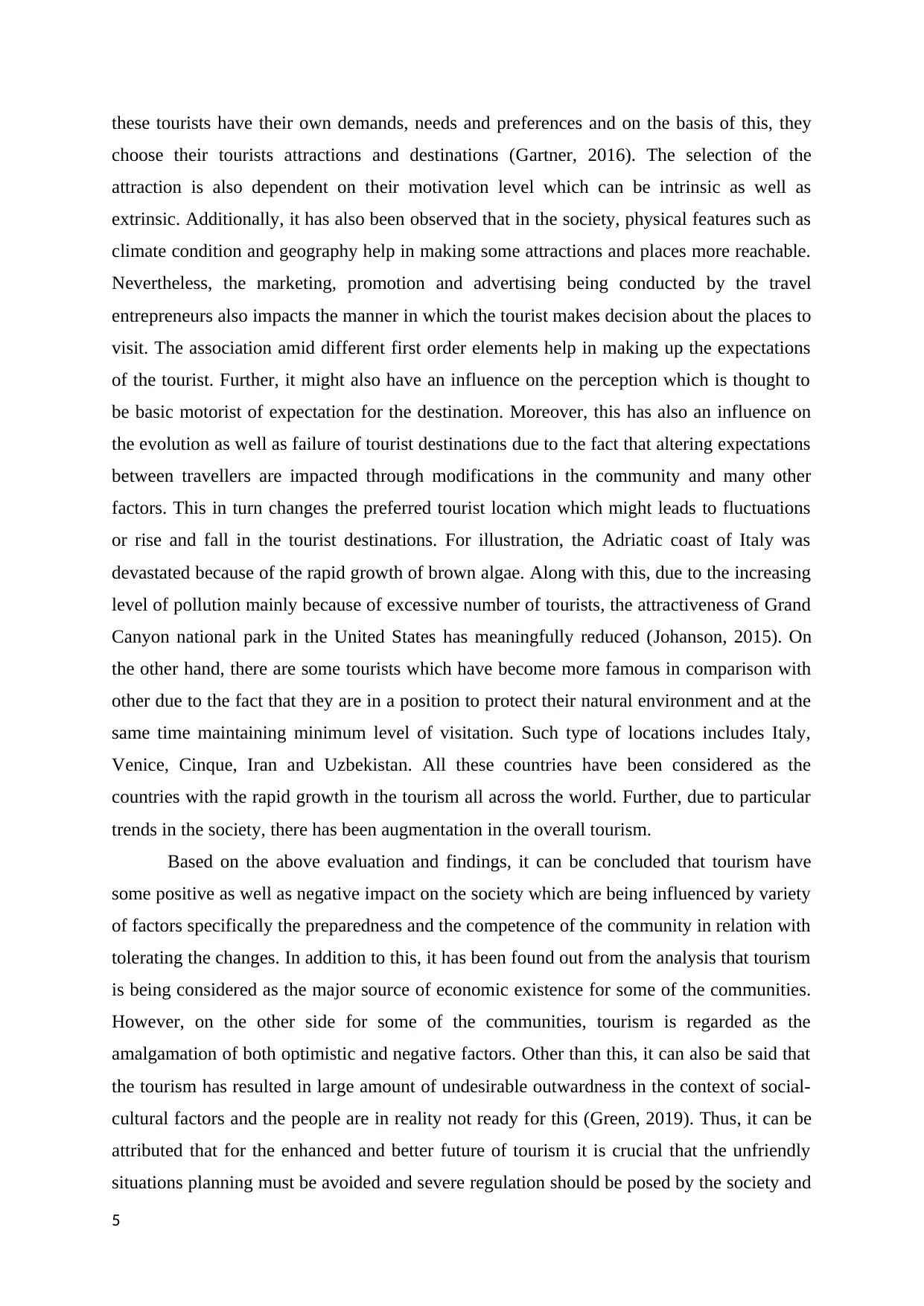
these tourists have their own demands, needs and preferences and on the basis of this, they
choose their tourists attractions and destinations (Gartner, 2016). The selection of the
attraction is also dependent on their motivation level which can be intrinsic as well as
extrinsic. Additionally, it has also been observed that in the society, physical features such as
climate condition and geography help in making some attractions and places more reachable.
Nevertheless, the marketing, promotion and advertising being conducted by the travel
entrepreneurs also impacts the manner in which the tourist makes decision about the places to
visit. The association amid different first order elements help in making up the expectations
of the tourist. Further, it might also have an influence on the perception which is thought to
be basic motorist of expectation for the destination. Moreover, this has also an influence on
the evolution as well as failure of tourist destinations due to the fact that altering expectations
between travellers are impacted through modifications in the community and many other
factors. This in turn changes the preferred tourist location which might leads to fluctuations
or rise and fall in the tourist destinations. For illustration, the Adriatic coast of Italy was
devastated because of the rapid growth of brown algae. Along with this, due to the increasing
level of pollution mainly because of excessive number of tourists, the attractiveness of Grand
Canyon national park in the United States has meaningfully reduced (Johanson, 2015). On
the other hand, there are some tourists which have become more famous in comparison with
other due to the fact that they are in a position to protect their natural environment and at the
same time maintaining minimum level of visitation. Such type of locations includes Italy,
Venice, Cinque, Iran and Uzbekistan. All these countries have been considered as the
countries with the rapid growth in the tourism all across the world. Further, due to particular
trends in the society, there has been augmentation in the overall tourism.
Based on the above evaluation and findings, it can be concluded that tourism have
some positive as well as negative impact on the society which are being influenced by variety
of factors specifically the preparedness and the competence of the community in relation with
tolerating the changes. In addition to this, it has been found out from the analysis that tourism
is being considered as the major source of economic existence for some of the communities.
However, on the other side for some of the communities, tourism is regarded as the
amalgamation of both optimistic and negative factors. Other than this, it can also be said that
the tourism has resulted in large amount of undesirable outwardness in the context of social-
cultural factors and the people are in reality not ready for this (Green, 2019). Thus, it can be
attributed that for the enhanced and better future of tourism it is crucial that the unfriendly
situations planning must be avoided and severe regulation should be posed by the society and
5
choose their tourists attractions and destinations (Gartner, 2016). The selection of the
attraction is also dependent on their motivation level which can be intrinsic as well as
extrinsic. Additionally, it has also been observed that in the society, physical features such as
climate condition and geography help in making some attractions and places more reachable.
Nevertheless, the marketing, promotion and advertising being conducted by the travel
entrepreneurs also impacts the manner in which the tourist makes decision about the places to
visit. The association amid different first order elements help in making up the expectations
of the tourist. Further, it might also have an influence on the perception which is thought to
be basic motorist of expectation for the destination. Moreover, this has also an influence on
the evolution as well as failure of tourist destinations due to the fact that altering expectations
between travellers are impacted through modifications in the community and many other
factors. This in turn changes the preferred tourist location which might leads to fluctuations
or rise and fall in the tourist destinations. For illustration, the Adriatic coast of Italy was
devastated because of the rapid growth of brown algae. Along with this, due to the increasing
level of pollution mainly because of excessive number of tourists, the attractiveness of Grand
Canyon national park in the United States has meaningfully reduced (Johanson, 2015). On
the other hand, there are some tourists which have become more famous in comparison with
other due to the fact that they are in a position to protect their natural environment and at the
same time maintaining minimum level of visitation. Such type of locations includes Italy,
Venice, Cinque, Iran and Uzbekistan. All these countries have been considered as the
countries with the rapid growth in the tourism all across the world. Further, due to particular
trends in the society, there has been augmentation in the overall tourism.
Based on the above evaluation and findings, it can be concluded that tourism have
some positive as well as negative impact on the society which are being influenced by variety
of factors specifically the preparedness and the competence of the community in relation with
tolerating the changes. In addition to this, it has been found out from the analysis that tourism
is being considered as the major source of economic existence for some of the communities.
However, on the other side for some of the communities, tourism is regarded as the
amalgamation of both optimistic and negative factors. Other than this, it can also be said that
the tourism has resulted in large amount of undesirable outwardness in the context of social-
cultural factors and the people are in reality not ready for this (Green, 2019). Thus, it can be
attributed that for the enhanced and better future of tourism it is crucial that the unfriendly
situations planning must be avoided and severe regulation should be posed by the society and
5
⊘ This is a preview!⊘
Do you want full access?
Subscribe today to unlock all pages.

Trusted by 1+ million students worldwide
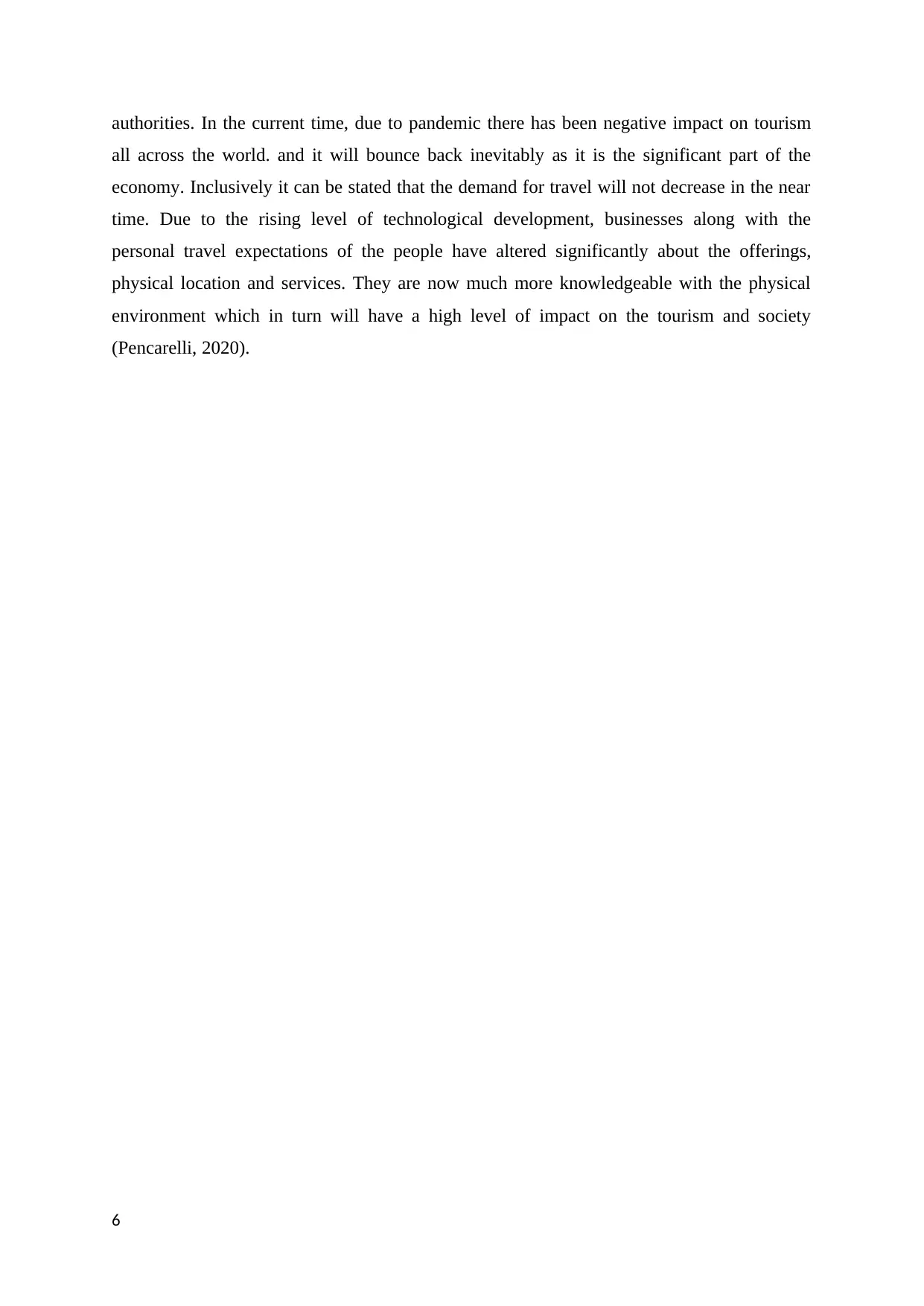
authorities. In the current time, due to pandemic there has been negative impact on tourism
all across the world. and it will bounce back inevitably as it is the significant part of the
economy. Inclusively it can be stated that the demand for travel will not decrease in the near
time. Due to the rising level of technological development, businesses along with the
personal travel expectations of the people have altered significantly about the offerings,
physical location and services. They are now much more knowledgeable with the physical
environment which in turn will have a high level of impact on the tourism and society
(Pencarelli, 2020).
6
all across the world. and it will bounce back inevitably as it is the significant part of the
economy. Inclusively it can be stated that the demand for travel will not decrease in the near
time. Due to the rising level of technological development, businesses along with the
personal travel expectations of the people have altered significantly about the offerings,
physical location and services. They are now much more knowledgeable with the physical
environment which in turn will have a high level of impact on the tourism and society
(Pencarelli, 2020).
6
Paraphrase This Document
Need a fresh take? Get an instant paraphrase of this document with our AI Paraphraser
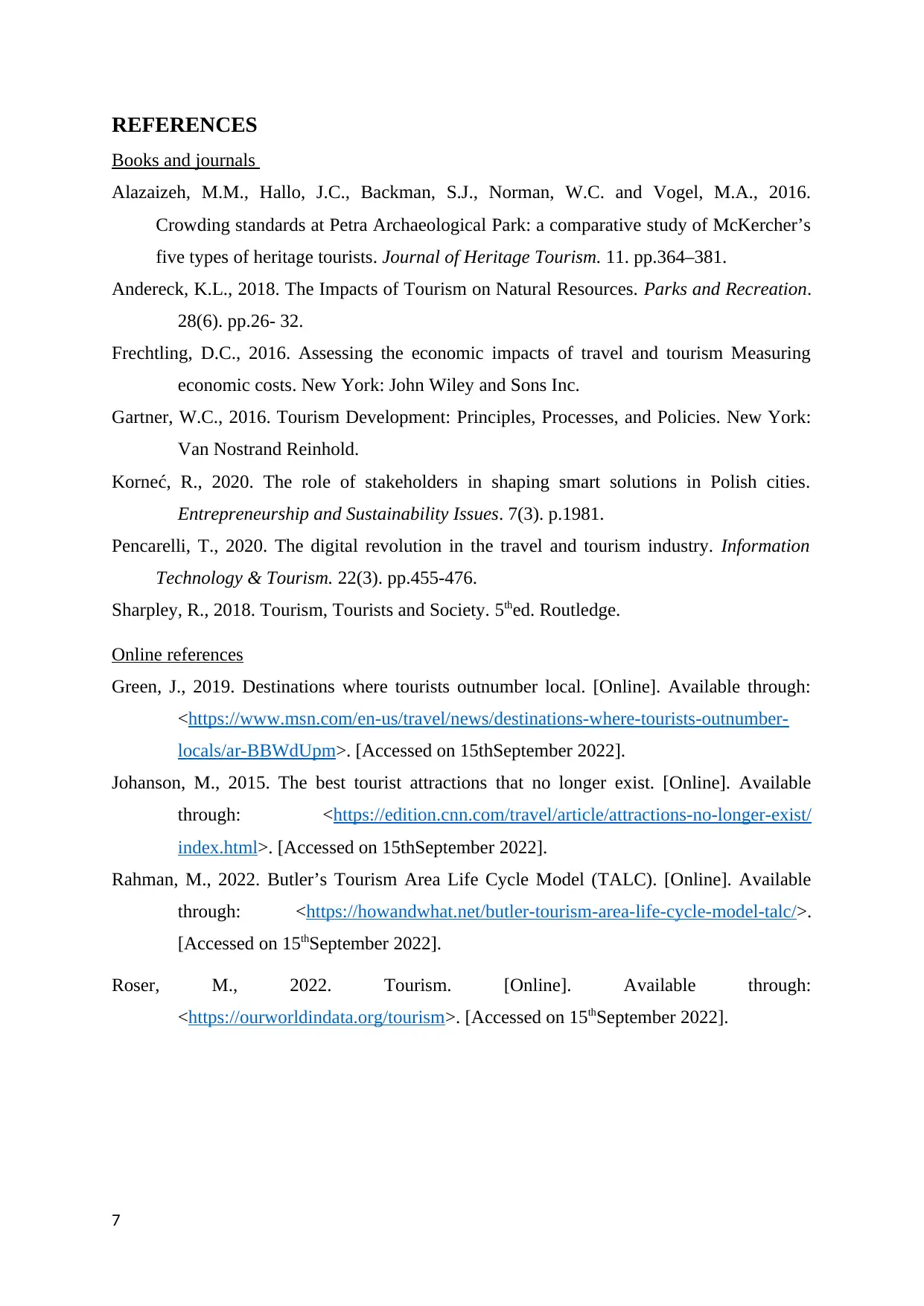
REFERENCES
Books and journals
Alazaizeh, M.M., Hallo, J.C., Backman, S.J., Norman, W.C. and Vogel, M.A., 2016.
Crowding standards at Petra Archaeological Park: a comparative study of McKercher’s
five types of heritage tourists. Journal of Heritage Tourism. 11. pp.364–381.
Andereck, K.L., 2018. The Impacts of Tourism on Natural Resources. Parks and Recreation.
28(6). pp.26- 32.
Frechtling, D.C., 2016. Assessing the economic impacts of travel and tourism Measuring
economic costs. New York: John Wiley and Sons Inc.
Gartner, W.C., 2016. Tourism Development: Principles, Processes, and Policies. New York:
Van Nostrand Reinhold.
Korneć, R., 2020. The role of stakeholders in shaping smart solutions in Polish cities.
Entrepreneurship and Sustainability Issues. 7(3). p.1981.
Pencarelli, T., 2020. The digital revolution in the travel and tourism industry. Information
Technology & Tourism. 22(3). pp.455-476.
Sharpley, R., 2018. Tourism, Tourists and Society. 5thed. Routledge.
Online references
Green, J., 2019. Destinations where tourists outnumber local. [Online]. Available through:
<https://www.msn.com/en-us/travel/news/destinations-where-tourists-outnumber-
locals/ar-BBWdUpm>. [Accessed on 15thSeptember 2022].
Johanson, M., 2015. The best tourist attractions that no longer exist. [Online]. Available
through: <https://edition.cnn.com/travel/article/attractions-no-longer-exist/
index.html>. [Accessed on 15thSeptember 2022].
Rahman, M., 2022. Butler’s Tourism Area Life Cycle Model (TALC). [Online]. Available
through: <https://howandwhat.net/butler-tourism-area-life-cycle-model-talc/>.
[Accessed on 15thSeptember 2022].
Roser, M., 2022. Tourism. [Online]. Available through:
<https://ourworldindata.org/tourism>. [Accessed on 15thSeptember 2022].
7
Books and journals
Alazaizeh, M.M., Hallo, J.C., Backman, S.J., Norman, W.C. and Vogel, M.A., 2016.
Crowding standards at Petra Archaeological Park: a comparative study of McKercher’s
five types of heritage tourists. Journal of Heritage Tourism. 11. pp.364–381.
Andereck, K.L., 2018. The Impacts of Tourism on Natural Resources. Parks and Recreation.
28(6). pp.26- 32.
Frechtling, D.C., 2016. Assessing the economic impacts of travel and tourism Measuring
economic costs. New York: John Wiley and Sons Inc.
Gartner, W.C., 2016. Tourism Development: Principles, Processes, and Policies. New York:
Van Nostrand Reinhold.
Korneć, R., 2020. The role of stakeholders in shaping smart solutions in Polish cities.
Entrepreneurship and Sustainability Issues. 7(3). p.1981.
Pencarelli, T., 2020. The digital revolution in the travel and tourism industry. Information
Technology & Tourism. 22(3). pp.455-476.
Sharpley, R., 2018. Tourism, Tourists and Society. 5thed. Routledge.
Online references
Green, J., 2019. Destinations where tourists outnumber local. [Online]. Available through:
<https://www.msn.com/en-us/travel/news/destinations-where-tourists-outnumber-
locals/ar-BBWdUpm>. [Accessed on 15thSeptember 2022].
Johanson, M., 2015. The best tourist attractions that no longer exist. [Online]. Available
through: <https://edition.cnn.com/travel/article/attractions-no-longer-exist/
index.html>. [Accessed on 15thSeptember 2022].
Rahman, M., 2022. Butler’s Tourism Area Life Cycle Model (TALC). [Online]. Available
through: <https://howandwhat.net/butler-tourism-area-life-cycle-model-talc/>.
[Accessed on 15thSeptember 2022].
Roser, M., 2022. Tourism. [Online]. Available through:
<https://ourworldindata.org/tourism>. [Accessed on 15thSeptember 2022].
7
1 out of 8
Related Documents
Your All-in-One AI-Powered Toolkit for Academic Success.
+13062052269
info@desklib.com
Available 24*7 on WhatsApp / Email
![[object Object]](/_next/static/media/star-bottom.7253800d.svg)
Unlock your academic potential
Copyright © 2020–2025 A2Z Services. All Rights Reserved. Developed and managed by ZUCOL.



